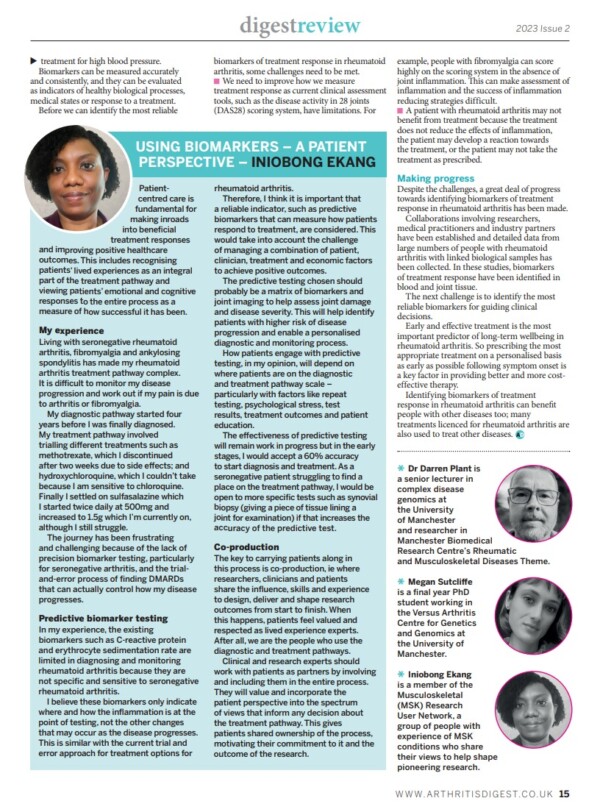Identifying biomarkers to improve treatment outcomes for rheumatoid arthritis patients – Dr Darren Plant speaks to Arthritis Digest
Arthritis Digest is a magazine for people with arthritis that highlights the latest relevant research and reviews topical issues.
Dr Darren Plant is a senior lecturer in complex disease genomics at the University of Manchester and researcher in Manchester Biomedical Research Centre’s (BRC) Rheumatic and Musculoskeletal Diseases Theme. Continuing regular contributions from our researchers, he explains that the future will see us identify biomarkers to improve rheumatoid arthritis treatment outcomes.
A rheumatoid arthritis diagnosis is no longer the millstone that people in the recent past experienced thanks to a plethora of new, effective treatments. But for some people, it takes time to find the drug that will bring their disease under control, and for an unlucky few, an effective long-term solution remains out of reach.
The treatment pathway for rheumatoid arthritis starts with conventional synthetic disease modifying anti-rheumatic drugs (DMARDs) that suppress the immune system to control inflammation. Low dose methotrexate is the cornerstone DMARD and is given to 60–88% of patients.
If this does not effectively control symptoms, patients may receive another DMARD (such as sulfasalazine) or may be escalated to receive biologic drugs or small molecule inhibitors, which target specific components of the immune system and are substantially more expensive.

Regardless of the drug used, around 40% of people do not find a treatment that works well for them, and we do not currently know which treatment is likely to be of most benefit for a particular patient.
How can biomarkers improve treatment outcomes?
One way treatment response could be improved is to use the patient’s own biology to guide which drug should be prescribed.

This would mean measuring the medical state of an individual with rheumatoid arthritis and using that information to select the treatment that is most likely to reduce symptoms. Treatment decisions would be shifted away from trial-and-error and improve long-term health for people affected.
One way to measure the medical state of individuals is to measure biological markers, otherwise known as biomarkers. Biomarkers are characteristics that can be measured in the body. For example, blood pressure is a biomarker that is used to diagnose and monitor response to treatment for high blood pressure.
Biomarkers can be measured accurately and consistently, and they can be evaluated as indicators of healthy biological processes, medical states or response to a treatment.
Before we can identify the most reliable biomarkers of treatment response in rheumatoid arthritis, some challenges need to be met:
- We need to improve how we measure treatment response as current clinical assessment tools, such as the disease activity in 28 joints (DAS28) scoring system, have limitations. For example, people with fibromyalgia can score highly on the scoring system in the absence of joint inflammation. This can make assessment of inflammation and the success of inflammation reducing strategies difficult.
- A patient with rheumatoid arthritis may not benefit from treatment because the treatment does not reduce the effects of inflammation, the patient may develop a reaction towards the treatment, or the patient may not take the treatment as prescribed.
Making progress
Despite the challenges, a great deal of progress towards identifying biomarkers of treatment response in rheumatoid arthritis has been made.
Collaborations involving researchers, medical practitioners and industry partners have been established and detailed data from large numbers of people with rheumatoid arthritis with linked biological samples has been collected. In these studies, biomarkers of treatment response have been identified in blood and joint tissue.
The next challenge is to identify the most reliable biomarkers for guiding clinical decisions.
Early and effective treatment is the most important predictor of long-term wellbeing in rheumatoid arthritis. So prescribing the most appropriate treatment on a personalised basis as early as possible following symptom onset is a key factor in providing better and more cost effective therapy.
Identifying biomarkers of treatment response in rheumatoid arthritis can benefit people with other diseases too; many treatments licensed for rheumatoid arthritis are also used to treat other diseases.
Using biomarkers – A patient perspective – Iniobong Ekang
Patient-centred care is fundamental for making inroads into beneficial treatment responses and improving positive healthcare outcomes. This includes recognising patients’ lived experiences as an integral part of the treatment pathway and viewing patients’ emotional and cognitive responses to the entire process as a measure of how successful it has been.
My experience
Living with seronegative rheumatoid arthritis, fibromyalgia and ankylosing spondylitis has made my rheumatoid arthritis treatment pathway complex. It is difficult to monitor my disease progression and work out if my pain is due to arthritis or fibromyalgia.

My diagnostic pathway started four years before I was finally diagnosed. My treatment pathway involved trialling different treatments such as methotrexate, which I discontinued after two weeks due to side effects; and hydroxychloroquine, which I couldn’t take because I am sensitive to chloroquine. Finally I settled on sulfasalazine which I started twice daily at 500mg and increased to 1.5g which I’m currently on, although I still struggle.
The journey has been frustrating and challenging because of the lack of precision biomarker testing, particularly for seronegative arthritis, and the trial and-error process of finding DMARDs that can actually control how my disease progresses.
Predictive biomarker testing
In my experience, the existing biomarkers such as C-reactive protein and erythrocyte sedimentation rate are limited in diagnosing and monitoring rheumatoid arthritis because they are not specific and sensitive to seronegative rheumatoid arthritis.
I believe these biomarkers only indicate where and how the inflammation is at the point of testing, not the other changes that may occur as the disease progresses. This is similar with the current trial and error approach for treatment options for rheumatoid arthritis.

Therefore, I think it is important that a reliable indicator, such as predictive biomarkers that can measure how patients respond to treatment, are considered. This would take into account the challenge of managing a combination of patient, clinician, treatment and economic factors to achieve positive outcomes.
The predictive testing chosen should probably be a matrix of biomarkers and joint imaging to help assess joint damage and disease severity. This will help identify patients with higher risk of disease progression and enable a personalised diagnostic and monitoring process.
How patients engage with predictive testing, in my opinion, will depend on where patients are on the diagnostic and treatment pathway scale – particularly with factors like repeat testing, psychological stress, test results, treatment outcomes and patient education.
The effectiveness of predictive testing will remain work in progress but in the early stages, I would accept a 60% accuracy to start diagnosis and treatment. As a seronegative patient struggling to find a place on the treatment pathway , I would be open to more specific tests such as synovial biopsy (giving a piece of tissue lining a joint for examination) if that increases the accuracy of the predictive test.
Co-production
The key to carrying patients along in this process is co-production, i.e where researchers, clinicians and patients share the influence, skills and experience to design, deliver and shape research outcomes from start to finish.
When this happens, patients feel valued and respected as lived experience experts. After all, we are the people who use the diagnostic and treatment pathways.
Clinical and research experts should work with patients as partners by involving and including them in the entire process. They will value and incorporate the patient perspective into the spectrum of views that inform any decision about the treatment pathway.
This gives patients shared ownership of the process, motivating their commitment to it and the outcome of the research.
Iniobong Ekang is a member of the Musculoskeletal (MSK) Research User Network. In collaboration with Vocal, the network is a group of people with experience of MSK conditions, who share their views to help shape pioneering research across Manchester BRC’s Rheumatic and Musculoskeletal Diseases Theme and beyond.
Identifying new biomarkers – A PhD student perspective – Megan Sutcliffe
In rheumatoid arthritis, joint inflammation is driven by a protein called tumour necrosis factor (TNF). By inhibiting the effects of this protein with a class of drugs called TNF inhibitors (TNFi), a reduction in rheumatoid arthritis symptoms can be achieved. As a result of this, TNFi are the most commonly prescribed class of biologic drugs in rheumatoid arthritis.
We know that a subset of immune cells called T-cells are centrally involved in rheumatoid arthritis disease processes. T-cells circulate in the peripheral blood, and when activated, initiate an immune response.
My research aims to identify a T-cell biomarker in patients that have started treatment with a TNFi so we can determine who is more likely to experience a beneficial response to TNFi, and who is more likely to benefit from a different drug targeting a dif erent disease pathway.

To do this I have looked at T-cells in the blood of people with rheumatoid arthritis before and after TNFi treatment. I have also measured disease activity to determine who did and did not respond to TNFi.
My research found a T-cell biomarker that is more abundant in patients who did not respond well to 12 weeks of TNFi treatment, compared to patients who did respond well. Furthermore, in patients who did not respond to treatment, the expression of a protein called CD8 was higher at 12 weeks compared to patients who responded to TNFi treatment. This protein is expressed on T-cells that have more aggressive and inflammatory characteristics, which is inline with high disease activity.
I plan to validate these findings in an independent group of people with rheumatoid arthritis, as it is important to ensure that my results are not due to chance.
The outcome? Long term, we are looking at the right treatment for the right person at the right time.
Megan Sutcliffe is a final year PhD student working in the Versus Arthritis Centre for Genetics and Genomics at the University of Manchester.